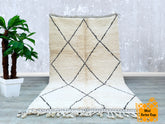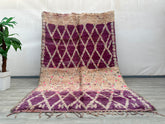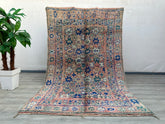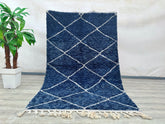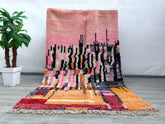Moroccan Rug Motifs and Patterns : A Closer Look.
Moroccan Rugs: A Blend of Art, Culture, and Tradition.
When you think of Moroccan rugs, the iconic Diamond pattern and its sister design, the Azilal, may come to mind. These rugs are admired worldwide for their bold patterns and motifs, each deeply rooted in Moroccan culture. More than simple decorations, these designs act as a visual language, symbolizing life, nature, and the heritage of the Berber people. By exploring the history and meaning behind these motifs, you can deepen your appreciation for this rich tradition.
Decoding the Symbols
Moroccan rug patterns originate from the Berber tribes, each design inspired by daily life, nature, and cultural beliefs. Here are a few key symbols and their meanings:
The Diamond
A prominent symbol in Moroccan rugs, the diamond is believed to protect against the evil eye, an ancient belief across North Africa. Smaller diamond patterns often accompany it to amplify this protective energy .
The Zigzag
Representing water, a precious resource in Morocco’s arid climate, the zigzag pattern also symbolizes life’s flow and energy, reflecting the constant movement and growth found in nature.
Triangles and Lozenges
Geometric shapes like triangles and lozenges are common in Moroccan rugs, symbolizing family unity. The triangles often represent family structure, including grandparents, parents, and children.
The Fish
Though less common, the fish is a symbol of water, fertility, and sacrifice. Rugs featuring this design often come from coastal regions where fishing plays a significant role in daily life.
Barleycorn Patterns
This design, typically a series of linked diamonds, symbolizes fertility and prosperity, reflecting the importance of agriculture in Moroccan culture.
The Bird
Seen as a symbol of luck and joy, the bird also represents freedom and the connection between heaven and earth.
The Art of Weaving
Creating a Moroccan rug is a labor-intensive process that demands skilled artistry. Artisans, primarily women, hand-weave each piece on traditional looms, with complex designs often taking months or even years to complete, depending on the size and intricacy of the pattern.
Materials and Techniques
High-quality wool is commonly used for its durability, softness, and natural sheen. Artisans use natural dyes, derived from plants and minerals, to create a vivid palette of colors, from cool blues to warm reds and yellows, adding depth and life to the intricate motifs.
A Modern Cultural Icon
Today, Moroccan rugs continue to be cherished not only for their cultural significance but also for their versatility in modern decor. Their striking designs and symbolic meanings complement a wide range of interiors, from traditional to contemporary, making them a favorite among interior designers and homeowners alike.
Tradition in a Contemporary World
The vibrant culture of Morocco is intricately woven into each rug, with every symbol telling a story of heritage and tradition. By learning the meanings behind these motifs, we can better appreciate the artistry of Moroccan rugs and celebrate the legacy they carry forward. These designs serve as a timeless connection between past and present, enriching homes around the world.
Featured Products
155 x 247 cm = 5.1 x 8.1 ft Diamonds Blue Soft Dots Berber Runner Rug - Handmade Moroccan Wool, Minimalist Design, Vintage Style, Perfect for Weddings & Bohemian Decor
- $599.00
$1,830.00- $599.00
- (-67%)
- Unit price
- / per
171 x 279 cm = 5.6 x 9.2 ft Colorful Abstract Moroccan Runner Rug - Handmade Berber Wool, Minimalist Design, Vintage Bohemian Style, Perfect for Weddings & Decor
- $599.00
$1,830.00- $599.00
- (-67%)
- Unit price
- / per
- authentic
- Authentic Moroccan rug
- Beni Rugs
- Beniouraincarpets
- Berber rug history
- Berber tribes
- Custom Beni Ourain Rug
- Custom Moroccan Rugs
- Hand-woven rugs
- Handmade carpet
- Luxury home decor
- Modern Beni rugs
- Moroccan Berber rug
- Moroccan rug aesthetics
- Moroccan rug authenticity
- Moroccan rug buying guide
- Plush area rug
- Plush texture rugs
- Rug interior alignment
- Rug personalization
- Timeless rug designs
- Vintage Moroccan Rug
- white beni ourain
- Wool Rug


